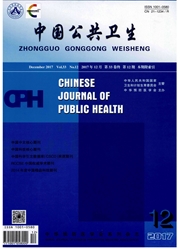

 中文摘要:
中文摘要:
目的 了解北京市和黑龙江省公众风险认知现状及主要影响因素。方法 2015年8—11月,根据经济发展水平,采用分层整群抽样方法抽取北京市(988人)和黑龙江省(971人)城市和农村居民进行风险认知现状问卷调查,采用SPSS 18.0软件对风险认知的可能性与严重性进行二元logistic回归分析。结果 不同特征居民风险认知比较,北京市居民整体水平高于黑龙江省居民,城市居民高于农村居民;事故灾难:北京市居民(3.09±1.03)分,黑龙江省居民(2.93±1.16)分,城市居民(3.09±0.03)分,农村居民(2.92±0.04)分;公共卫生事件:北京市居民(2.90±1.00)分,黑龙江省居民(2.69±1.12)分,城市居民(2.85±0.03)分,农村居民(2.73±0.04)分;暴力恐怖事件:北京市居民(2.63±0.97)分,黑龙江居民(2.46±1.09)分,城市居民(2.68±0.03)分,农村居民(2.39±0.03)分,差异均有统计学意义(P〈0.01)。是否残疾在风险认知可能性与严重性单因素分析中均有统计学意义(P〈0.05)。多因素逻辑回归显示,是否残疾、是否购买保险、居住的房屋类型是北京市和黑龙江省居民风险认知的影响因素(P〈0.05);身体残疾的居民风险发生严重性的认知程度高于健康人群(OR=1.727,95%CI=1.024~2.911);楼房居民对风险认知的严重性程度高于平房居民(OR=1.373,95%CI=1.063~1.773);北京居民的公众风险认知度高于黑龙江居民(OR=1.290,95%CI=1.052~1.582)。结论 区域间公众风险认知水平存在差异;了解公众风险认知水平有助于提高公众应急能力水平。
 英文摘要:
英文摘要:
Objective To examine the level of risk perception and its influencing factors among citizens in Beijing municipality and Heilongjiang province. Methods Using stratified random cluster sampling, we selected 988 and 971 cit- izens living in regions with different economic development levels in Beijing municipality (Beijing) and Heilongjiang province (Heilongjiang) for a survey on risk perception with a self-designed questionnaire between August and September 2015. We performed statistics description and binary logistic regression to analyze the data collected using SPSS 18.0. Results Compared to those in Heilongjiang and in rural regions,the citizens in Beijing and in urban regions reported significantly higher level of risk perception, with the dimension scores for natural disaster ( 3. 09 ± 1. 033 for Beijing citizens vs. 2. 93 ± 1. 160 for Heilongjiang citizens and 3.09 + 0. 034 for urban citizens vs. 2. 92± 0. 037 for rural citizens) ,public health event (2. 90 ± 1. 001 vs. 2. 69 ± 1. 123 and 2. 85 ± 0. 032 vs. 2. 73 ± 0. 036), and violent terrorist incident (2. 63 ±0. 976 vs. 2. 46 ± 1.090 and 2. 68±0. 032 vs. 2. 39 ±0. 034) ,respectively (P 〈0. 01 for all). The results of univariate analysis showed that whether being with disability was a significant impact factor on the perception of risk possibility (Xz = 5. 148 ) and severity (X2 = 4. 570 ) ( both P 〈 0.05 ). The results of multivariate logistic regression revealed that age, whether purchasing insurance, and housing type were main influencing factors of risk perception ; the citizens with disabilities (odds ratio[ OR ] = 1. 727,95 % confidence interval [ 95 % CI] = 1. 024 -2. 911 ), living in high buildings ( OR = 1. 373,95 % CI = 1. 063 - 1. 773 ), and residing in Beijing ( OR = 1. 290,95 % CI = 1. 052 - 1. 582) were more likely to have risk awareness than those with healthy condition,living in bungalows ,and residing in Helongjiang. Conclu- sion The level of risk perception is different amo
 同期刊论文项目
同期刊论文项目
 同项目期刊论文
同项目期刊论文
 期刊信息
期刊信息
